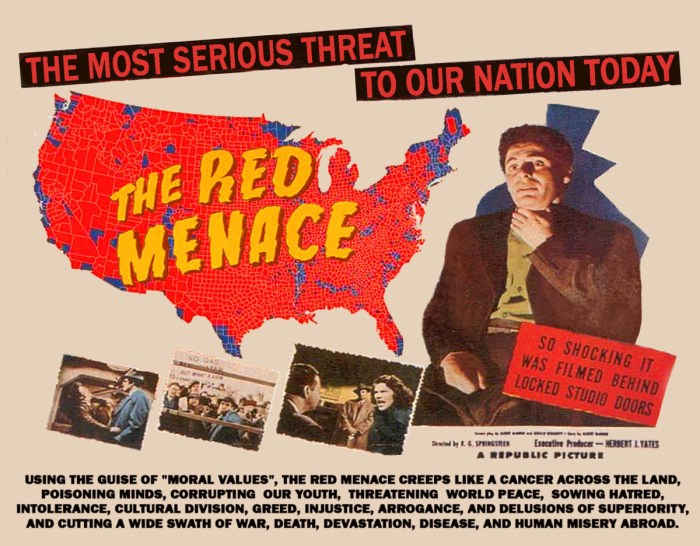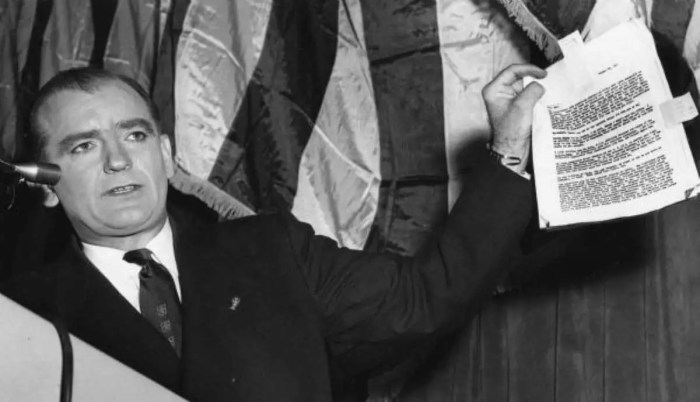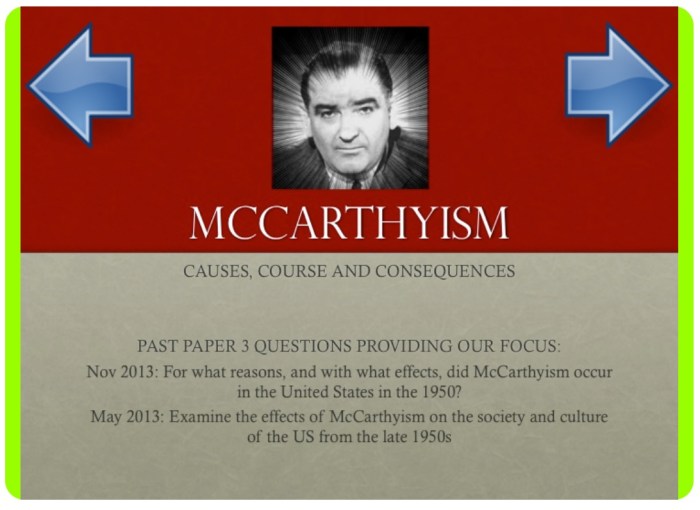The Red Scare and McCarthyism Webquest embarks on a compelling journey into a pivotal era marked by fear, suspicion, and the erosion of civil liberties. This webquest delves into the historical context, key players, and profound impact of this tumultuous period, shedding light on a chapter in American history that continues to resonate today.
During the Cold War, the United States grappled with a pervasive fear of communism, fueled by political tensions and the threat of nuclear conflict. Senator Joseph McCarthy emerged as a leading figure in this anti-communist crusade, employing aggressive tactics and public hearings to accuse individuals of disloyalty and communist sympathies.
Historical Context of the Red Scare and McCarthyism: The Red Scare And Mccarthyism Webquest

The Red Scare and McCarthyism were fueled by the political and social climate of the Cold War, a period of heightened tension between the United States and the Soviet Union. Fear of communism permeated American society, stemming from concerns about Soviet expansionism and espionage.
Key events leading up to the Red Scare included the Yalta Conference, the Potsdam Conference, and the establishment of the Truman Doctrine.
Origins and Motivations Behind the Fear of Communism
- Soviet expansionism in Eastern Europe
- Allegations of Soviet espionage in the United States
- Ideological differences between capitalism and communism
- Political opportunism and domestic policy goals
Timeline of Key Events
- 1945: Yalta Conference
- 1945: Potsdam Conference
- 1947: Truman Doctrine
- 1949: Hiss Case
- 1950: McCarthy’s Wheeling speech
- 1954: Army-McCarthy hearings
Senator Joseph McCarthy and His Role
Rise of Joseph McCarthy and His Anti-Communist Crusade
Joseph McCarthy, a Republican senator from Wisconsin, became the face of the Red Scare in the early 1950s. He launched a highly publicized anti-communist campaign, accusing government officials and other individuals of being communists or communist sympathizers.
McCarthy’s Tactics and Methods
- Public hearings and accusations
- Use of innuendo and unsubstantiated claims
- Targeting of prominent individuals and institutions
- Creation of a climate of fear and suspicion
Impact of McCarthy’s Actions
- Damage to reputations and careers
- Erosion of civil liberties
- Heightened political tensions
- Weakening of American institutions
The Hollywood Blacklist
Origins and Implementation of the Hollywood Blacklist
The Hollywood blacklist was an informal agreement among film studios to deny employment to individuals suspected of communist sympathies. It was initiated in the late 1940s and lasted for over a decade.
Impact of the Blacklist on the Film Industry
- Loss of talented actors, writers, and directors
- Self-censorship and conformity
- Decline in the quality of films
- Damage to the reputation of Hollywood
Examples of Individuals Who Were Blacklisted
- Dalton Trumbo
- Charlie Chaplin
- Lillian Hellman
- Orson Welles
Impact on American Society

Social and Cultural Consequences
The Red Scare and McCarthyism created an atmosphere of fear and suspicion in American society. People were afraid to speak their minds or associate with those who held different political views.
Atmosphere of Fear and Suspicion
- Citizens informing on neighbors and friends
- Government surveillance and investigations
- Self-censorship and conformity
- Decline in trust and social cohesion
Long-Term Effects of McCarthyism
- Erosion of civil liberties
- Weakening of democratic institutions
- Damage to American reputation abroad
- Legacy of fear and suspicion
Comparisons to Other Historical Events

Similarities and Differences
The Red Scare and McCarthyism have been compared to similar events in other countries and time periods, such as the Salem witch trials, the Spanish Inquisition, and the Nazi persecution of Jews. While there are similarities in terms of tactics, motivations, and outcomes, there are also important differences.
Lessons Learned, The red scare and mccarthyism webquest
- Importance of protecting civil liberties
- Dangers of political opportunism
- Need for critical thinking and skepticism
- Consequences of mass hysteria
Key Questions Answered
What were the origins of the Red Scare?
The Red Scare emerged from a combination of post-World War II tensions, fear of nuclear conflict, and the rise of communist movements around the globe.
How did McCarthy’s tactics contribute to the Red Scare?
McCarthy’s aggressive public hearings, unsubstantiated accusations, and use of fear and intimidation created a climate of suspicion and hysteria.
What was the impact of the Hollywood blacklist?
The Hollywood blacklist led to the dismissal and persecution of hundreds of actors, writers, and directors suspected of communist sympathies, severely damaging the film industry and stifling creative expression.
